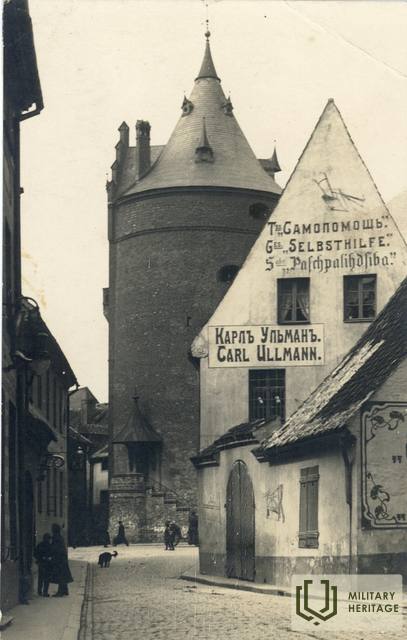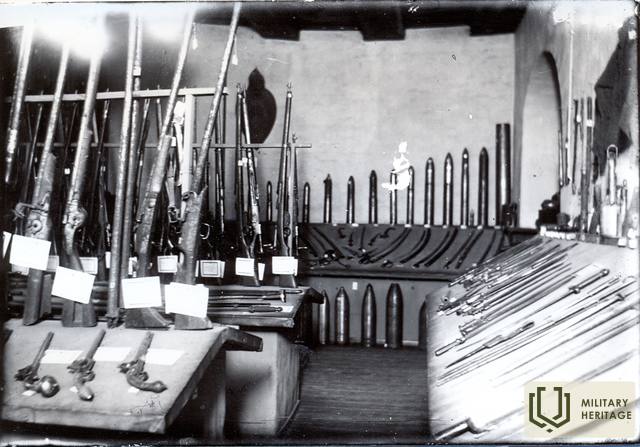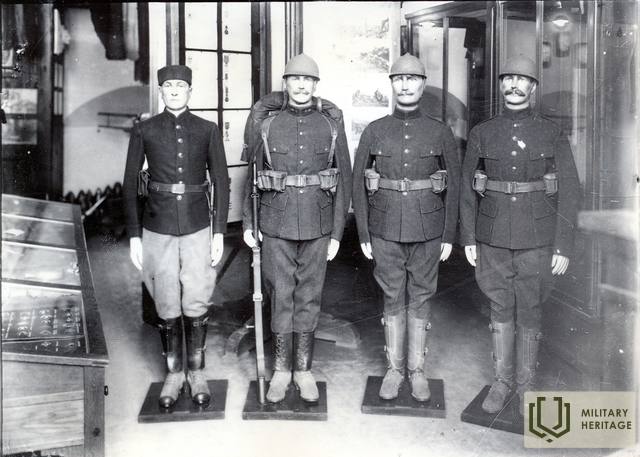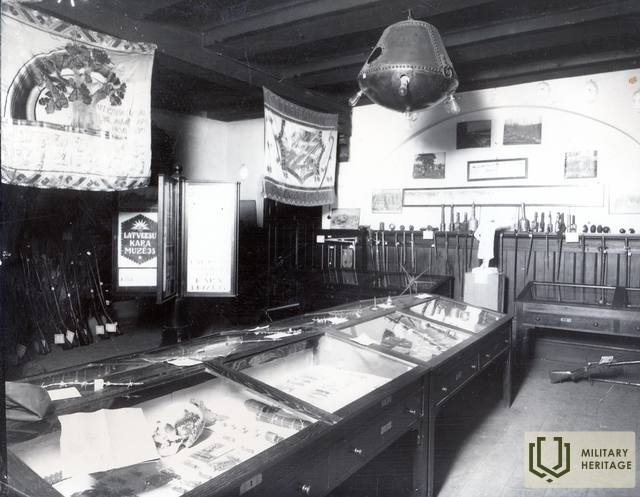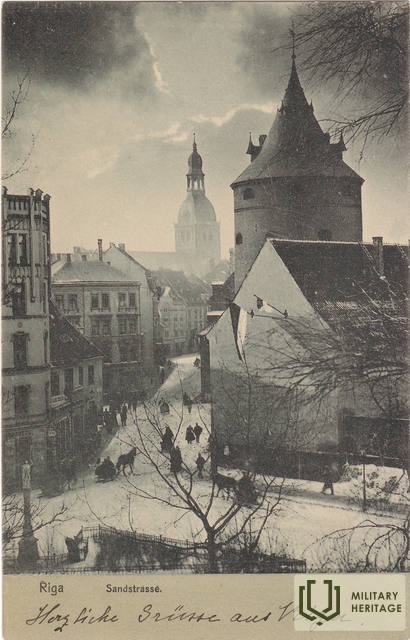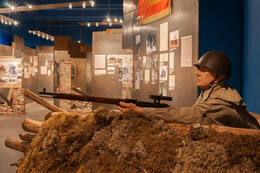Karo muziejaus kūrimo pradžios prisiminimai
Pasakotojas aprašo aplinkybes, kuriomis buvo įkurtas Karo muziejus. Paminėtos problemos ir kolekcijų kūrimo darbai.
„Viena iš neatidėliotiniausių mūsų laikų užduočių – surinkti ir sutvarkyti viską, kas liudija apie tuos niokojimo ir karo metus, kurie mūsų tėvynę pavertė griuvėsių krūva. Karo bangos liejosi kaip potvyniai ir atoslūgiai, tačiau tik iš šių griuvėsių buvo lemta atgimti naujajai Latvijai. Mūsų didvyriški šaulių batalionai pirmieji drąsiai stojo kaip pirmasis kovai pasirengęs kolektyvas už savo žemę ir iškovojo mūsų laisvę tik su ginklais rankose. Todėl, kol dar nevėlu, turime grįžti prie darbo ir surinkti visą medžiagą apie šį laikmetį Karo muziejuje ir archyvuose, nušviečiant padėtį Latvijoje prieš karą, latvių išvykimą ir pabėgėlių gyvenimą, šaulių gyvenimą ir mūšių, okupacijos epochą, ypač Kurše, Raudonojoje Latvijoje ir pirmuosius Latvijos valstybės žingsnius. Latvijos karo muziejus buvo įkurtas 1916 m. lapkritį, kai Latvijos šaulių pulkams buvo leista rinkti atitinkamą medžiagą, trofėjus ir kt. 1917 m. pradžioje jo veikla jau buvo įsibėgėjusi, buvo pakviesti darbuotojai, o muziejaus kolekcijos pamažu pildomos.“ augo. 1917 m. gegužę buvo apie 8000 vienetų. Jo veikla gerokai išsiplėtė, kai jis prisijungė prie Pabėgėlių paramos komiteto archyvo, kuriame buvo sukaupta daug medžiagos ir kuris, sunaikinus Maskvos kultūros biurą ir Sankt Peterburgo archyvus, dabar yra vienintelė kolekcija su pabėgėlių laikų dokumentais. Be trofėjų kolekcijos, kurioje yra daug vokiškos karo atributikos, yra ir kitų didelių skyrių. Surinkta didelė dalis išleistos vokiškos karo literatūros apie Pabaltijį, įvairūs dokumentai, laikraščiai, laiškai ir kt. Archyve saugomi pilni karo metu leistų laikraščių ir kitų spausdintų medžiagų rinkiniai, šūkiai, plakatai, reglamentai ir kt. Nuotraukų kolekcijoje, kuri turėjo patekti į visų mūsų fotografų kompanijas, yra žuvusių didvyrių nekrologai, kareivių atsiminimai, dienoraščiai, laiškai, apibūdinantys laikmetį ir kt. Yra skyrius, kuriame aprašomos kareivių laisvalaikio akimirkos – jų įranga, aliuminio liejiniai ir kt. Karo muziejui pastaraisiais metais teko įveikti įvairius sunkumus. 1917 m. buvo sunku trofėjus tiesiogiai perduoti muziejui, nes jie turėjo tekėti bendra tvarka per skyrius ir pan. į Centrinę trofėjų kolekciją Sankt Peterburge. Muziejus galėjo juos laisvai priimti, kareiviai oficialiai negalėjo jų perkelti, o tai sukėlė didelių nepatogumų. Okupacijos metu vokiečiai kolekciją buvo iškasę, bet suinteresuotų asmenų rūpesčiu ji buvo sutvarkyta. Panašiai ir bolševikų laikais muziejus turėjo būti skubiai perkeltas iš ankstesnių patalpų, ten persikėlė komunistų komitetai. Tačiau energingais darbuotojų veiksmais pavyko ją išsaugoti ir šį kartą papildyti kolekciją. Dabar Karo muziejus vėl pradeda savo veiklą su tam tikra praeitimi ir kolekcijomis. Plačiai aprašomi šie etapai: 1917 m. Rygoje ir Vidžemėje iki okupacijos, pabėgėlių era ir „Bolševikų laikai Latvijoje. Labiausiai reikia papildyti kolekcijas apie okupaciją Kurše, Latvijos kareivius Rusijoje, belaisvių gyvenimą Vokietijoje ir užsienio informaciją karo metu. Todėl prašome visų muziejaus draugų vėl atvykti ir padėti šiame darbe, pateikti jam aktualius daiktus, dokumentus ir kolekcijas.“
„Latvijas Sargs“, Nr.84. 1919 m
Susijusi laiko juosta
Susijusios temos
Susijusios vietos
Latvijos karo muziejus
Latvijos karo muziejus yra įsikūręs senamiestyje, netoli Laisvės paminklo, istoriniame gynybos pastate, vadinamame „Parako bokštu“. Muziejuje yra 11 eksponatų. Čia eksponuojami įvairūs ginklai, dokumentai, uniformos, apdovanojimai, ženkleliai ir kiti daiktai, pasakojantys apie kasdienį kareivio gyvenimą kare. Latvijos karo muziejus yra vienas seniausių muziejų Latvijoje. Jo ištakos siekia Pirmąjį pasaulinį karą. Muziejaus kolekciją daugiausia sudarė asmeniniai kareivių daiktai arba mūšio laukuose rasti daiktai. Latvijai atgavus nepriklausomybę, pagrindinis muziejaus tikslas tapo sukurti ekspoziciją apie Latvijos karo istoriją ir aktyvų gyventojų vaidmenį saugant savo žemę. 1937 m. muziejus buvo išplėstas ir techniškai buvo vienas moderniausių tuo metu Europoje. Parako bokštas buvo vienas iš Rygos įtvirtinimų bokštų. Kai kurie įrodymai siekia 1330 m., kai jis buvo minimas kaip „Smėlio bokštas“. Bokštas buvo sugriautas 1621 m., kai Rygą apgulė Švedijos armija. Tačiau 1650 m. buvo pastatytas naujas bokštas parakui ir ginklams laikyti. Nugriovus miesto įtvirtinimus, Parako bokštas išlieka vienu svarbiausių Rygos gynybos sistemos įrodymų.




